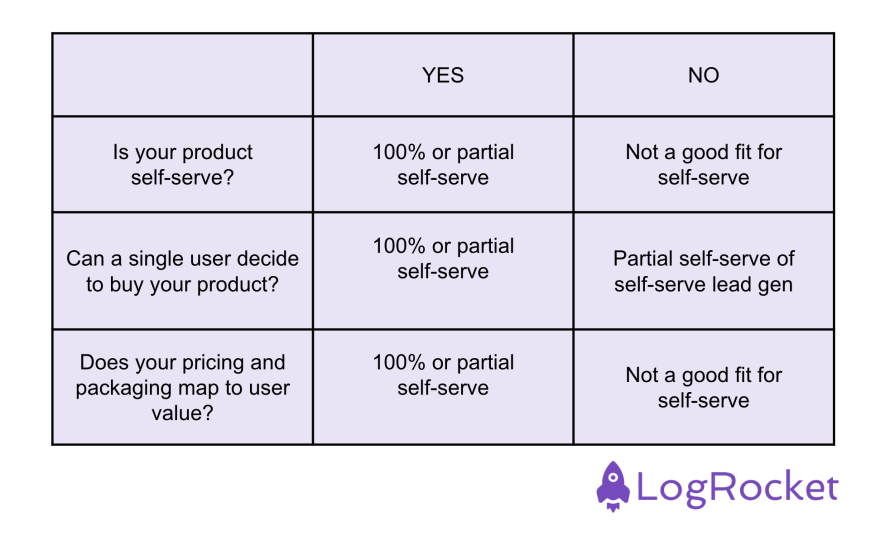Some of the most successful products over the last decade leveraged self-serve product strategies, and you’ve probably heard of them! Slack, Dropbox, and Airtable are just a few who have successfully leveraged a self-serve strategy to drive company growth.

In this post, we’ll cover everything you need to know about self-serve product strategies to decide whether or not you should do it. We’ll talk about how to choose the right form factor and execute your chosen strategy. Let’s dive in!
A self-serve product strategy involves building and delivering a product to customers without requiring interaction with the sales team. Traditionally, when you want to purchase a product, you have to get in touch with a salesperson. This is true when you enter a brick-and-mortar store like Macy’s or if you want to purchase a piece of software through a contact sales form.
In contrast, new technologies that enable self-checkout allow users to shop for and buy products without going through sales! Self-serve product strategies are powerful because they lower barriers to adoption by making it easier for users to buy, and typically have a lower cost associated with acquiring and retaining customers.
It’s important to note that although a self-serve product strategy sounds great, it’s not a good fit for every product. That’s because some products are simply too complex or too expensive for customers to buy with the click of a button (houses, cars, and complex software products are just a few examples).
Selling these products typically requires a longer sales cycle where you might show the user a demo and allow them to trial the product. You might even choose to do custom work and services to win a deal.
There are three questions you can ask yourself to decide whether or not a self-serve strategy is a good fit for you:
Some products are a great fit for self-serve while others aren’t. For example, calendar apps like Calendly have a clear self-serve flow, whereas products that require extensive data integration like IBM Watson do not.
Of course, one could argue that with enough time and resources, most products could be completely self-serve. However, it’s important to consider prioritization and the difficulty of a given task. Sometimes, certain products are simply so hard to make self-serve, and customers are so unlikely to buy those products in a self-serve manner, that it’s not worth investing time in doing so.
When you have a self-serve product, you want to make sure that the user who is getting value out of your product is also the one who will make the buying decision. That’s because any friction in the self-serve buying funnel is bound to impact your conversion rates, and having to talk to a manager or get buy-in from different teams to buy is the biggest friction of all! Those complex sales processes that span multiple teams are what salespeople are best at, so you shouldn’t try to replace that expertise with a self-serve product.
Finally, in addition to making sure a single user can make a buying decision, you also want to make sure that there is a clear way to expand a single user. What I mean by this is, let’s say that you build a project management task app like Asana.
A single user can come in, decide to use Asana, and then start paying for a “Pro” plan. As they grow with Asana, they may want to invite their team members to expand into a “Business” plan. The value they are getting out of Asana is cross-team collaboration, so the more team members they bring on, the more value they are getting out of the product.
Similarly, if you’re thinking about implementing a self-serve product strategy, you’ll want to identify the most natural value vector. This is the unit of measurement that most closely aligns with the value customers are getting out of your product.

A self-serve product strategy does not just encompass the product itself, but rather how your customer experiences your product end-to-end. This starts with how they find your product in the first place all the way up to how they continue to use your product years later.
Unlike sales-led organizations where sales teams might conduct outbound sales, contacting potential customers that match the ideal customer profile, self-serve products need to be discovered by the customer on their own with no sales involvement. That’s why getting your marketing and positioning right is important! You need to be able to convince a customer, just from your website, that your product is worth trying out.
You can also think of ways to drive virality. Perhaps users don’t just discover you via marketing, but rather through communities they are involved in, newsletters they subscribe to, or even their friends who refer them. All of these tactics that drive inbound interest are key to a successful self-serve strategy.
Most self-serve products allow users to try things out before they buy, although some require you to start paying in order to test out the product. In either case, both options involve an onboarding period where the user decides whether or not to continue using the product. The more users that you can capture during this phase, the more revenue you can generate over time.
Some important strategies to think through here all revolve around optimizing for the best onboarding experience possible. This includes engaging with users so that they have all the information they need to test the product. You will also want to think through how to get users to value as quickly as possible. And perhaps you’ll consider email drip campaigns to guide users through the product.
There are many tools in the market to help with every aspect of user onboarding, so you don’t necessarily have to build them yourself. However, you do need to cover all of these aspects to build a truly great self-serve product strategy.
Once users have decided to pay you and use your product, you need to ensure that they fully adopt the product. Again, self-serve products push users to adopt products with no sales involvement. They do this by progressively guiding users through an ideal adoption path, building nurture email campaigns, and much more. All of these components add up to a fluid user adoption experience.
Finally, self-serve product strategies should think beyond the first time a user pays to how users expand with the product. Perhaps they buy your product again and again, or perhaps they expand their usage of your product and spend more. The path towards upselling customers and keeping them around should also be an area of investment in your self-serve product strategy.

It’s important to note that self-serve product strategies typically fall on a spectrum. Some products are 100 percent fully self-serve. This means that at no point does sales ever really need to get involved. You might have customer support and customer success helping customers on a one-off basis, but the way customers discover and experience your product is entirely self-serve.
On the other side of the spectrum of self-serve product strategy is leveraging self-serve as a channel to drive lead generation for sales. For example, perhaps you have a simple self-serve version of your product that captures good-fit customers. Your sales team can then use that list of self-serve customers to drive real revenue by reaching out to the most active customers. The biggest difference between treating self-serve as lead gen vs being 100 percent self-serve is that when self-serve is used as lead gen, there is no real expectation that self-serve will ever be a full revenue driver.
And then, of course, many companies live on the partially self-serve spectrum. This is when you combine a 100 percent self-serve product strategy with a more tops-down sales motion for more complex customers. It is very common for companies to fall into this category. Even ideal self-serve companies like Slack had sales teams that would deal with larger enterprise contracts. As you mature as a self-serve product, more likely than not you will end up somewhere in the middle whether you like it or not, simply because larger deals often require a sales touch.
Now that we’ve covered what a self-serve product strategy is and what it’s made up of, how do you choose the right self-serve product strategy for you? Let’s return to the three questions you should ask yourself to determine whether or not you should do self-serve in the first place, and use that as a framework for choosing the right self-serve product strategy:

You’ll notice that if your answer is “yes” to these questions, you can consider 100 percent or partial self-serve. When should you choose 100 percent self-serve or partial self-serve? Ultimately, it comes down to a question of market size.
Typically, 100 percent self-serve products are “prosumer” products, meaning that they involve single users paying for the product. If your market is large enough for you to capture enough single users to pay for your product to build a meaningful business, then by all means, stay in the 100 percent self-serve product space. However, if at any point, you want to move up the market to expand your market size, you’ll likely need to take the partial self-serve approach. Enterprise contracts with greater than $100k ACVs will never happen with a self-serve product driven by credit card swipes.
The other thing to note is that really only the first question is a make-it-or-break-it question. If your product isn’t self-serve, you simply can’t implement a self-serve product strategy. However, this isn’t true of the second question of whether or not a single user can buy your product. You can make a version of self-serve work if more than a single user needs to make a buying decision. That’s because you can always create a self-serve version that serves a single user, and use the more advanced version as an upsell path. That upsell path may involve sales, but the initial capture of that first user doesn’t involve sales.
And finally, on pricing and packaging, you can always change your pricing and packaging to map better to value. But be careful because pricing and packaging become harder to change as your company grows bigger. So definitely be thoughtful about how you want to price and why.
Most companies today have adopted some version of a self-serve product strategy, whether it’s simply to capture more leads for sales to work on, or if it’s the entire company’s go-to-market strategy. As you think through self-serve product strategies, remember that being self-serve isn’t black or white. You can fit your product onto a spectrum between being 100 percent self-serve and 100 percent sales-led depending on the unique characteristics of your product.
At the end of the day, businesses are complex, and getting self-serve product strategies to work is something that you’ll continue to optimize and improve throughout the entire lifetime of your business.

LogRocket identifies friction points in the user experience so you can make informed decisions about product and design changes that must happen to hit your goals.
With LogRocket, you can understand the scope of the issues affecting your product and prioritize the changes that need to be made. LogRocket simplifies workflows by allowing Engineering, Product, UX, and Design teams to work from the same data as you, eliminating any confusion about what needs to be done.
Get your teams on the same page — try LogRocket today.

Most teams fail at autonomy. Learn how clear rules help product teams move faster without micromanagement.

A practical framework for PMs to use AI in ideation without sacrificing judgment, strategy, or decision quality.

A practical five minute revenue estimation method to help product managers compare ideas, drop low impact features, and prioritize smarter.

A practical guide for PMs who want to stop being bottlenecks, delegate smarter, and lead teams effectively with a clear ownership framework.